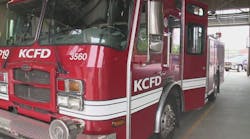One of the greatest challenges faced by today's emergency services managers is people. Not enough people to respond, not enough people to serve on committees, not enough people to take on added responsibilities and not enough people to do all the jobs that need to get done.
The biggest challenge faced by today's volunteer firefighter or EMS provider is time. Not enough time with the spouse and kids, not enough time to devote to our careers and not enough time to do what we love to do: volunteer.
The volunteer's challenge thus becomes the volunteer manager's challenge. Inasmuch as the fire department struggles to be everything it once was to the community, few individual volunteers have the time to be everything they once were to the fire department.
For over 200 years, the fire department has always been the go-to guys for virtually everything. If you needed your flooded basement pumped out, whom do you call? If a storm knocks down a tree and it blocks the roadway -the fire department gets called to cut up the tree and remove the hazard. Who do even the police call when they can't handle a situation? When the power goes out and the traffic and streetlights are dark at every intersection in your town, the police call on the fire department to fill in and take over until power and order are restored.
In addition to being the "Jacks-of-all-trades" in natural and man-made emergencies, the fire department was once the social epicenter of the community. The firehall is where your kids go to Boy or Girl Scout meetings. It's where the community gathers to vote, and it's where they gather to demonstrate their support for another community member who has fallen on hard times. And it's the place your friends and neighbors go to on Friday nights for a Lenten Fish Fry or just to share stories and a beverage. Our fathers and mothers joined, as did their fathers and mothers. And we joined too.
So, how can we get the same job done with the same set of people who have less time to volunteer? The blunt reality is, we can't any longer. Ouch. That's harsh.
OK then, what are our options? One option is to cut down on the overall workload to be done. This could mean reducing the total number of services you provide to your community. And that can be a double-edged sword.
Reducing services can lead to reduced public support - financially and morally. While this can be accomplished with minimal collateral damage, it has to be managed properly - a discussion we'll save for Part 2. Fortunately... there are alternatives. Read on.
Another option is to attract more people to do smaller jobs individually. In other words, reduce the workload of each volunteer, and by utilizing a larger total number of volunteers, collectively get the same or more work done. This option doesn't come without its own set of challenges, though. First of all, there's the small problem of "where are we going to find more people? You might say to yourself, "They're not exactly breaking down our door to get in now!"
It all starts with a needs analysis. This is an idea that's not new to traditional businesses and it's an idea well covered in recruitment and retention resources like Chief Jack Snook's "A Breed Apart" program and the "Problems and Solutions" guide published jointly by the National Volunteer Fire Council, FEMA and the US Fire Administration.
Before you quantify - you must qualify! What do you need more volunteers for? What specific jobs do you need them to perform and how many volunteers do you need to perform each job function? What type of volunteer is best suited to get the job done? Do you need someone capable of running into burning buildings or someone just as capable of balancing your department's financial books?
An honest needs analysis both quantifies and qualifies your need for more volunteers. It sets the stage for how you structure, or re-structure your membership, as well as how you plan to attract the new volunteers you need. Once you've completed the analysis you then need to create the opportunities for more people to volunteer. Your challenge is create a work environment where people are allowed to work within their comfort zone - to specialize.
For example, I don't change the oil in my own car. Why would you want me responsible for maintaining or even checking the mechanical needs of a quarter million dollar piece of fire apparatus? But I do have my own comfort zone - my own set of talents or specialties. I'm one of a few people who are comfortable in front of a camera articulating the needs of my department and the community in an emergency. My fire chief, who through no fault of his own, is not as comfortable as I am in front of a camera or microphone. Thus, he appointed me as Public Information Officer and trusts me to deliver an accurate portrayal of the given situation and to promote our department in the proper light.
As a good manager, he lets me work within my comfort zone and, as a result, I strive to do a good job for him and the department. His challenge, and that of every other chief officer, is to identify each of our strengths and weaknesses and to utilize us to the best of our given set of talents.
My department allows our individual volunteers to specialize, to be good at a few things instead of poor at a lot. We've opened our membership to offer the ultimate in flexibility. You can join to do firefighting only, EMS only, rescue only, fire police only or as an associate member to serve the department in a non-emergency role for administration and support.
However, adding more volunteers at the bottom of the typical fire department organizational pyramid comes with a price. While the division of workload is spread across the widening bottom of the pyramid, it causes a shift of burden to the top of the pyramid.
As I say in my Top Ten Commandments for Recruitment and Retention, "Be careful what you wish for. More members equal more help, but it also equates to more people to manage and more personalities and people issues to deal with." However, this can't deter you from recruiting more.
In fact, you may have to look at adding more "middle management" just to support, supervise, communicate with and motivate the specialists at the bottom of the organization chart.
As I stated earlier, few fire departments today can continue to be everything they once were to the community and few volunteers can afford the time to be everything they once were to the fire department.
I'm big on balance these days. As a manager in today's emergency services community, your challenge, should you decide to accept it, is to educate and empower your volunteers to achieve balance at home, work, school, play and the firehouse. No easy task by any means. But a necessary evil nonetheless to survive and prosper in today's competitive environment.
Tiger Schmittendorf, a Firehouse.com contributing editor, serves the County of Erie Department of Emergency Services as Deputy Fire Coordinator, overseeing the operation and administration of three training academies, 40 fire instructors and the training of 94 fire departments and 5,000+ firefighters. He is a Certified Fire Instructor and a firefighter with the Evans Center Fire Company in the Town of Evans NY for 22 years, currently serving as Captain, Public Information Officer (PIO) and Webmaster.
Schmittendorf also consults fire departments and municipalities nationally as Creative Director for OnScene Marketing Services ? the first marketing team responding to the needs of the emergency services community. He created a recruitment effort that doubled his own fire department?s membership and helped net 525+ new volunteers countywide. He suffers from an extremely dry sense of humor and routinely makes an ass of himself, often in public.





